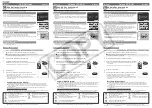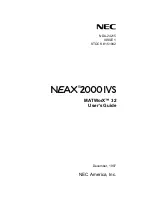
Chapter 6: DigiRack Real-Time TDM and RTAS Plug-ins
63
Church
A dense, diffuse space simulating a
church or cathedral with a long decay time,
high diffusion, and some pre-delay.
Plate
Simulates the acoustic character of a
metal plate-based reverb. This type of reverb
typically has high initial diffusion and a rela-
tively bright sound, making it particularly good
for certain percussive signals and vocal process-
ing. Plate reverb has the general effect of thick-
ening the initial sound itself.
Room 1
A medium-sized, natural, rich-sounding
room that can be effectively varied in size be-
tween very small and large, with good results.
Room 2
A smaller, brighter reverberant charac-
teristic than Room 1, with a useful adjustment
range that extends to “very small.”
Ambient
A transparent response that is useful for
adding a sense of space without adding a lot of
depth or density. Extreme settings can create in-
teresting results.
Nonlinear
Produces a reverberation with a natu-
ral buildup and an abrupt cutoff similar to a
gate. This unnatural decay characteristic is par-
ticularly useful on percussion, since it can add
an aggressive characteristic to sounds with
strong attacks.
Size
The Size control, in conjunction with the Algo-
rithm control, adjusts the overall size of the re-
verberant space. There are three sizes: Small,
Medium, and Large. The character of the rever-
beration changes with each of these settings (as
does the relative value of the Decay setting). The
Size buttons can be used to vary the range of a
reverb from large to small. Generally, you
should select an algorithm first, and then
choose the size that approximates the size of the
acoustic space that you are trying to create.
Diffusion
Diffusion sets the degree to which initial echo
density increases over time. High settings result
in high initial build-up of echo density. Low set-
tings cause low initial buildup. This control in-
teracts with the Size and Decay controls to affect
the overall reverb density. High settings of diffu-
sion can be used to enhance percussion. Use low
or moderate settings for clearer and more natu-
ral-sounding vocals and mixes.
Decay
Decay controls the rate at which the reverb de-
cays after the original direct signal stops. The
value of the Decay setting is affected by the Size
and Algorithm controls. This control can be set
to infinity on most algorithms for infinite re-
verb times.
Pre-Delay
Determines the amount of time that elapses be-
tween the original audio event and the onset of
reverberation. Under natural conditions, the
amount of Pre-Delay depends on the size and
construction of the acoustic space, and the rela-
tive position of the sound source and the lis-
tener. Pre-Delay attempts to duplicate this phe-
nomenon and is used to create a sense of
distance and volume within an acoustic space.
Long Pre-Delay settings place the reverberant
field behind rather than on top of the original
audio signal.
Hi Frequency Cut
Hi Frequency Cut controls the decay character-
istic of the high frequency components of the
reverb. It acts in conjunction with the Low-Pass
Filter control to create the overall high fre-
quency contour of the reverb. When set rela-
Summary of Contents for DigiRack
Page 1: ...DigiRack Plug ins Version 7 3 ...
Page 10: ...DigiRack Plug ins Guide 4 ...
Page 14: ...DigiRack Plug ins Guide 8 ...
Page 36: ...DigiRack Plug ins Guide 30 ...
Page 100: ...DigiRack Plug ins Guide 94 ...
















































